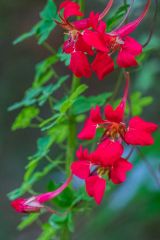
Cluny House Gardens is a 6-acre woodland garden set on a hillside above the River Tay. The garden features a wonderful collection of Himalayan plants and Asiatic primulas and is one of the best places in Britain to see the elusive red squirrel.
History
In 1949 a veterinary surgeon named Bobby Masterton purchased a hillside property on the north bank of the River Tay, east of Aberfeldy. Masterton loved plants and animals but loved the peace and quiet of the countryside. He set up his veterinary practice in Cluny House and over the next 36 years planted the hillside around the house with a mix of Japanese, Himalayan and North American plants to create a beautiful woodland garden.
The mix of moderate rainfall, acidic soil and a canopy provided by existing tall trees such as conifers, beeches and oak made Cluny House the ideal location for Masterton's garden. Masterton helped sponsor a plant-hunting expedition to Bhutan in 1949 and began planting his garden with 400 packets of seeds brought back by the plant-hunters. Many of these seeds were gathered at an altitude of 3000-4250m (about 10,000-14,000 ft).

He planted Tibetan cherry trees, with their distinctive peeling bark and perennials such as poppies and lilies. One species of lily planted by Masterton is now over 4 metres tall.
The garden covers 2.4 hectares (about 6 acres), set in the stunning scenery of the Strathtay valley.
Cluny is a 'natural' garden, with plants allowed to reseed themselves, protected by a canopy of birch, rowan and rhododendrons. No chemicals are used, and all weeding is done by hand. I can vouch for the latter point; as I was wandering about the garden I came upon a bent figure carefully digging weeds. It proved to be the garden owner, the daughter of the original founder. She was hard at work creating space for interesting seedlings to take hold.
Cluny is part of Perthshire's famed 'Big Tree Country', and though trees are not necessarily the main feature of the gardens there are several notable examples, including a Wellingtonia (Sequoiadendron) with the widest girth of any conifer in Britain at over 11 metres (36 feet). It stands 33.5m high (110 feet). This tree may have been grown from seeds gathered by John Matthew, a Perthshire botanist, in 1853.
Candelabra primulas grow in lush profusion under the tree canopy, while other colourful species include blue poppies, skunk cabbages, arisaemas and giant Himalayan lilies. April is the best time of year for seeing woodland bulbs in bloom, including trilliums and erythroniums.

Red Squirrels at Cluny
Cluny is one of the best places in Britain to view red squirrels and roughly a dozed squirrels live in the woodlands at Cluny. The native red squirrel has been driven away from major population centres by the larger and more aggressive grey squirrel.
At Cluny red squirrels thrive and can easily be spotted as you walk through the woodland. They are especially fond of the two giant Sequioadendrons and can often be spotted climbing the tree's soft bark.
Though you might come upon them at any time the best place to find red squirrels is at the feeding station at Signpost #5.
We tiptoed up to the feeding station and within 10 seconds saw a red squirrel coming to grab a few tasty seeds. Over the next 15 minutes as we watched and took photographs the squirrel came back again and again. Though it kept a close eye on us, it seemed comfortable enough with our presence so we were able to take quite a few photos without disturbing it.
Aside from red squirrels, Cluny is also a very good place to watch for birds. Species like chaffinches, robins, woodpeckers, starlings, and siskins are frequent visitors, while buzzards fly overhead.
Cluny is a delight to explore. It is a lovely mix of informal and woodland gardens, planted with a profusion of exotic plants and trees.

Visiting
Access is straightforward. Cluny House Garden is signposted off the B846 just north of Aberfeldy. From Aberfeldy head north across Wade's Bridge on the B846 and turn right at Weem onto the minor road to Cluny and Strathtay. The garden entrance is about 3 miles ahead on your left (uphill). Be careful, as the drive is very narrow with only a few passing places. There is a small car park outside the garden.
There is an information panel and an honesty box at the garden entrance, with laminated information sheets on garden highlights which you can take with you as you explore. There is also a selection of walking sticks freely available. These are very handy in wet weather to avoid slipping on the garden trails.
There is a recommended route, but you are free to wander as you choose. The recommended route is signposted with arrows and numbered posts in the ground, with each post corresponding to a point of interest on the laminated information sheets.
About Cluny House Gardens
Address: Cluny House,
Aberfeldy,
Perthshire,
Scotland, PH15 2JT
Attraction Type: Garden
Location: On a minor road off the B846 north-east of Aberfeldy.
Website: Cluny House Gardens
Location
map
OS: NN873509
Photo Credit: David Ross and Britain Express
HERITAGE
 We've 'tagged' this attraction information to help you find related historic attractions and learn more about major time periods mentioned.
We've 'tagged' this attraction information to help you find related historic attractions and learn more about major time periods mentioned.
Find other attractions tagged with:
NEARBY HISTORIC ATTRACTIONS
Heritage Rated from 1- 5 (low to exceptional) on historic interest
Grandtully, St Mary's Church - 0.8 miles (Historic Church) ![]()
Aberfeldy Water Mill - 1.6 miles (Museum) ![]()
Aberfeldy, St Andrew's Church - 1.7 miles (Historic Church) ![]()
Black Watch Memorial - 1.7 miles (Historic Building) ![]()
General Wade's Bridge - 1.7 miles (Historic Building) ![]()
Moness Cup-Marked Stone - 1.8 miles (Prehistoric Site) ![]()
Birks of Aberfeldy - 1.8 miles (Countryside) ![]()
Old Kirk of Weem - 2 miles (Historic Church) ![]()











